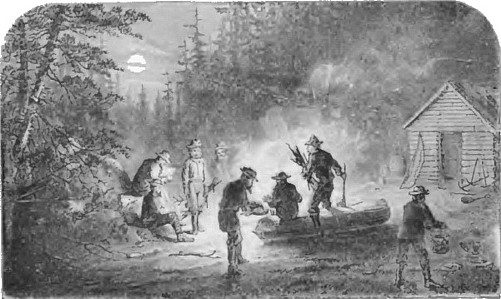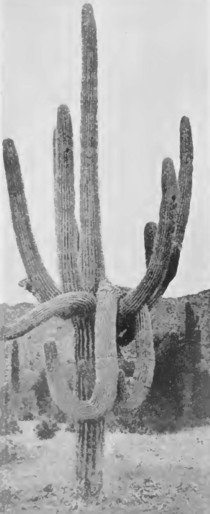Ever since the Americans first came to Arizona there have been current stories of "Lost Mines." The earliest of these stories were usually of mines belonging to the Jesuit padres and were supposed to be worked by Indians whom the friars enslaved, the poor natives toiling long hours in the bowels of the earth, and when not working, fastened by chains to the walls of rocky caverns to keep them from running away. These mines, of course, were fabulously rich, chunks of native gold as big as one's fist and masses of silver weighing thousands of pounds being as common as cobblestones in a river bottom, and all, according to these stories, were covered up at the time of the uprising of the Pima Indians in 1751 and their locations lost with the expulsion of the Jesuits by the Spanish rulers in 1767.
This is pure fiction as there is no evidence whatever to support the persistent tradition that the Jesuits owned mines in Arizona. As we have seen elsewhere, mining was carried on to a limited extent during the years they did missionary work in Arizona as we learn from extracts from Padre Kino's report, "Even in sight of these new missions some good mining camps of very rich silver ore are being established." However, the Jesuits were striving to save the souls of Indians, not to profit in a material way by their labor. After the Jesuit stories of lost mines grew stale, more modern ones took their places in after supper talks of prospectors as they sat about their camp fires under the Arizona stars, with distant yelping of coyotes for orchestral accompaniment. One of the most interesting of these stories, and one that undoubtedly had a foundation of fact, was that concerning the "Lost Soldier Mine."
In 1869, Abner McKeever and his wife were killed by Apaches near the big bend in the Gila River and his daughter Belle was taken prisoner. As soon as word reached the nearest military post, several small parties of mounted soldiers were started on the trail. One of these detachments was composed of Sergeant Grossthwaite, Privates Joe Wormley and Eugene Flannigan, who journeyed across the hot, forbidding desert to the north of the river.
Becoming confused in their bearings, the three wandered among the cacti and creosote bushes until two of the horses fell exhausted. With death from thirst staring them in the face, the soldiers, taking some of the horse flesh with them, pushed ahead hoping soon to find water. That same night, in following up an arroyo in some low, broken mountains they came upon a spring just in time to save their lives. After they had assuaged their burning thirst they fell into an exhausted sleep. When they awoke in the morning, so the story goes, they found nuggets of pure gold in the bottom of the spring, and all about were scattered lumps of gold-bearing quartz, besides two quartz veins on the canyon wall above the spring, which were so impregnated with gold the men dug grains of the yellow metal out with their knives.
They loaded fifty pounds of the quartz on their remaining horse and started back for the Gila River. En route, overcome by thirst and heat, Grossthwaite and the horse died and Flannigan, a little later, wholly spent, crawled under a stunted mesquite to die. Wormley, the hardiest of the three, finally reached the river delirious and all but dead. Later, a rescuing party reached Flannigan in time to save his life, then found the horse and brought in the quartz from which $1800 in gold was obtained. Wormley and Flannigan made many attempts to retrace their steps but without success. They never found the lost mine, and though for years afterwards prospectors scoured the country, the desert still holds its mystery.
The "Lost Dutchman Mine" derived its name from a German who, from time to time, used to visit Wickenburg to buy supplies. Always he had his burros laden with quartz so rich in gold that it drove the inhabitants of the town half mad with covetousness and wholly mad with exasperation when they were unable to get even the remotest hint from the taciturn prospector as to where his mine lay. Many attempts were made to both follow and track him, but slipping away at night with the feet of his burros tied in gunny sacks, he always succeeded in eluding his pursuers. One time he failed to come back and the desert hid another story in its grim bosom.
In the '60s, an Indian brought to Arizona City a lump of gold as big as the palm of his hand and traded it for beads and booze, boasting largely that he knew where he could get plenty more when that was gone. Bribes, coaxing nor threats could not induce him to tell the location of his Golconda; he said that nobody must know but himself. When he disappeared one day, "The Lone Indian Mine" was added to the mysteries and legends of the desert sands.
Then there is the story that tells of one of the old, nomadic, War Department camels leading a man to a desert "tank" or declivity in a rock which collected water in the rainy season. Here, so the story ran, there was even more gold scattered about than at the Lost Soldier Mine. Another story, located in Yavapai County, tells of a ledge known to the Yavapai Indians where they used to dig the yellow metal out of the rocks and make rifle bullets from it. This likely was inspired by Felix Aubrey's story of the Indian who shot a rabbit with a gold bullet.
THE DIAMOND HOAX
Perhaps the greatest mining hoax that ever was perpetrated in Arizona was
the alleged discovery in 1872 of a
diamond field in the northeastern part of the Territory. Two men by
the names of Arnold and Slack were supposed to be the discoverers, and
magnificent-looking rough diamonds and rough rubies, which it is said they
had picked up in the Arizona field, were exhibited in San Francisco. A
company with a capital of ten million dollars was organized in San Francisco
and the list of stockholders included a number of large mining investors.
The fraud was exposed by Clarence King,
United States Geologist, who
showed that the stones exhibited were from Africa and Brazil, and upon
visiting the Arizona fields, saw at once that it was not diamond-bearing
country. A second fake diamond field was located near the mouth of the Gila.
Return
to The Arizona Page:
Arizona Gold Rush Mining History



